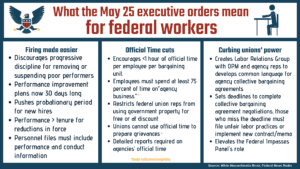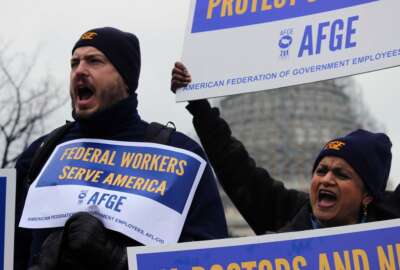
Despite court decision, unions still feel impacts of Trump’s workforce executive orders
At least three agencies have issued bargaining proposals that are similar to the provisions outlined in the President's three workforce executive orders, which ...
Soon after a federal district court overturned key provisions of the President’s three workforce executive orders last year, federal unions declared the court’s decision a win.
The executive orders, which President Donald Trump signed last May, prompted agencies with soon-to-be or expired collective bargaining agreements to begin charging federal unions rent to use government office space. Some agencies imposed limits on unions’ use of official time.
After the August decision, the Office of Personnel Management told agencies to “fully comply” with the court order.
But more than a year after the President signed the three workforce executive orders, federal employee unions, attorneys and some members of Congress have said they are still seeing the EOs’ impacts.
Broadly speaking, the climate around federal employee discipline has changed, said Cheri Cannon, an attorney at Tully Rinckey who represents federal workers.
“We’re seeing an effect on some agencies with how long the performance improvement periods are,” she said. “They are obviously taking a harder line. We have seen an uptick, quite frankly, in disciplinary actions across the board. Every week we get new cases of people being fired all over the government. Whereas before, people were being fired, [but] it just wasn’t at the pace we’re seeing.”
A provision in the employee removal EO — which wasn’t enjoined by the federal district court — prevents agencies from removing information about a disciplinary action or poor conduct from an employee’s personnel file. Agencies and employees often agreed to remove information about a disciplinary action from an employee’s personnel record in exchange for easy settlement, but that option is no longer on the table for most organizations, Cannon said.
“The agencies are more emboldened than they were before,” she said. “I’m not saying these are bad actions or bad faith actions, but agencies appear to feel freer to move forward with things that they might have taken longer with before or tried to work out with employees.”
November guidance from the Office of Personnel Management encouraged agencies to use their best judgment to determine how they could implement the broad concepts of the President’s workforce executive orders in their collective bargaining negotiations.
“The court’s decision does not limit or otherwise modify agency or union collective bargaining rights and obligations under the Federal Service Labor-Management Relations Statute,” the OPM guidance reads. “This includes the agency’s right to make proposals in the context of collective bargaining, including over subjects that were discussed in the executive orders, and to fashion those proposals in a manner that best reflects critical agency priorities.”
For Joanna Friedman, an attorney with the Federal Practice Group, the EOs have altered more than the overall climate of negotiations between federal employees and management: they’ve given agencies a playbook for the proposals they’re pursuing in collective bargaining negotiations.
“Right now in terms of collective bargaining and union rights in government, it’s a very ugly, ugly environment for members of a union,” Friedman said.
Unions see HHS, NTEU negotiations as potential model
At least three agencies have issued new bargaining proposals within the last year that mirror some of the provisions in the President’s workforce executive orders, some of which were enjoined by the federal district court.
Disagreements are perhaps most contentious between the Department of Health and Human Services and the National Treasury Employees Union.
NTEU has said the disagreements began nearly a year ago, when HHS offered new bargaining proposals last June. The union has said the President’s workforce executive orders revived bargaining negotiations that had previously been stalled. NTEU has said it originally approached HHS about reopening its contract back in July 2015. The two parties spent two years negotiating the ground rules for contract discussions but couldn’t agree.
Both HHS and NTEU attempted to negotiate last summer and briefly met a few times, according to the union. Both parties then spent much of December discussing new bargaining proposals with help from a federal mediator, which the Federal Service Impasses Panel (FSIP) ordered after HHS had declared an impasse in negotiations over the summer.
The panel earlier this spring ruled on 22 proposals from both the agency and the union. Several of the proposals resemble provisions in the President’s workforce executive orders that were overturned in court. The FSIP consists of a body of seven presidentially-appointed members.
“There is no doubt that some of the proposals and tactics we’ve seen at the bargaining table from HHS were in line with the anti-employee, anti-union tenor of the President’s executive orders from May 2018,” NTEU National President Tony Reardon said in a statement to Federal News Network.
HHS bargaining unit employees, for example, have no more than 30 days to demonstrate performance during an official review — a provision in the President’s workforce executive orders that the court overturned.
Similar to another overturned provision in the workforce EOs, the impasses panel also allowed NTEU to rent agency office space rather than use it free of charge.
Both HHS and NTEU also debated several changes to official time, but the impasses panel didn’t impose a hard limit. The President’s workforce executive orders set a 25 percent cap on the use of official time, but the court invalidated that provision.
Now after the FSIP decision, both HHS and NTEU appear to fundamentally disagree about where negotiations stand between them.
“As ordered by the Federal Service Impasses Panel, HHS will begin implementation of its new contract with NTEU,” a department spokeswoman said in a statement to Federal News Network. “HHS will be providing internal guidance on the implementation as the implementation process moves along. It is HHS’s expectation that the changes in the contract will increase the operational efficiency and effectiveness of the department.”
NTEU, however, disagrees.
“It is our position that the contract articles covered by the Federal Service Impasses Panel order cannot be implemented because six other articles remain outstanding, include the article that sets the effective date of the contract and when it ends,” Reardon said. “By law, the terms of the collective bargaining agreement, properly negotiated and revised in 2014, remain in effect until a complete successor agreement is reached.”
The parties haven’t set a date to negotiate the remaining articles, Reardon added. NTEU has filed five grievances over this matter with the Federal Labor Relations Authority, which still can’t issue an official decision without a Senate-confirmed general counsel.
Bargaining proposals mirror EO provisions at VA, SSA
The American Federation of Government Employees has said it sees the HHS-NTEU situation as a model for their negotiations with other agencies.
“We anticipate that it’s the wind in the agency’s sails,” David Cann, AFGE’s director of field services and education, said of HHS. “The reason they feel so emboldened to slough off their obligation to negotiate in earnest is because they know they’ll get whatever they want rubber-stamped by the panel.”
The situation at HHS has AFGE concerned about the status of negotiations of two other agencies.
More than 150 House members have written to SSA Administrator Nancy Berryhill to express their concerns with the agency’s recent bargaining proposals. According to members of Congress, SSA has proposed the American Federation of Government Employees vacate and return agency-owned office space and supplies. Cuts to official time are also part of the SSA bargaining proposals.
“We are deeply concerned that the Social Security Administration may have deliberately precipitated a breakdown in negotiations by insisting on proposals that are both extreme and similar in anti-union tone to certain provisions of executive orders 13836, 13837 and 13839,” the letter reads. “Such extreme proposals make it appear that the Social Security Administration is seeking to circumvent the order of the United States District Court, which enjoined many provisions of the executive orders.”
Recent bargaining proposals from the Department of Veterans Affairs make several suggestions that are similar to the provisions detailed in the President’s workforce executive orders.
If the proposals move forward, VA, for example, suggested charging AFGE rent for the union’s use of agency office space. Employees would no longer be able to use the union grievance process to appeal disciplinary actions for performance, according to the VA proposals.
The department also suggested additional cuts to official time. VA’s proposed limit on official time of 10,000 for the entire bargaining unit is more severe than what the provision in the President’s workforce EOs had suggested, which restricted official to no more than 25 percent of working hours for union representatives.
“They took the enjoined proposals, which they’re not allowed to further, as a blueprint for their proposals on those matters,” AFGE’s Cann said. “From where I sit at the table, they’re in flagrant violation of the district court’s injunction.”
VA and AFGE have settled on 18 weeks of negotiations, which start at the end of May, scheduled through the end of the year.
The Trump administration has also appealed the federal district court’s decision. The U.S. Court of Appeals heard oral arguments in the case in April. A decision may come from the appeals court this summer.
Copyright © 2024 Federal News Network. All rights reserved. This website is not intended for users located within the European Economic Area.
Nicole Ogrysko is a reporter for Federal News Network focusing on the federal workforce and federal pay and benefits.
Follow @nogryskoWFED







